General. Later, mainly long-stay elderly (female)
The Bermondsey Medical Mission was established in 1904 by Dr Selina Fox in what was at that time one of the poorest districts in London.
Dr Fox, the daughter of the renowned civil engineer Sir Francis Fox (1844-1927), had received her medical qualification in 1899, after studying at the London School of Medicine for Women and the General Infirmary, Newcastle-upon-Tyne. A typical pioneer woman doctor and a champion of the poor and disadvantaged, she took up a post at the missionary training school in Riley Street, Bermondsey, which was run by the Church Missionary Society. In 1900 she travelled to India for the Zenana Bible and Medical Mission to take up the post of Assistant Medical Officer at the Lady Kinnaird Memorial Hospital in Lucknow. However, she could not stand the hot climate and she soon returned to England. In 1901 she returned to the missionary training school in Riley Street. In 1903 she obtained an M.D., a higher degree in medicine, from Durham University.
Her work proved very popular among the poor
of Bermondsey (she treated over 6,000 patients in the two years after
her return), but the Society felt it was too expensive for them - it
did not want to run a mission in Bermondsey - and its funds should be
used to provide
missionaries for work overseas.
In 1904 Dr Fox decided to found her own Mission and asked the Society
to
release her. A small Committee, consisting of her, her father and
two others was formed. A suitable property was sought in
Bermondsey and, on a final tour of the area, Dr Fox and her father
spotted a man about to affix a notice stating "This house to let, apply
within" to the window of a house with a gelatine lozenge. They
were granted first refusal for 24 hours and the next day, No. 44
Grange Road was leased, with
an option of purchase within 5 years. The house had a small
garden and, beyond that, a burnt-out factory and a ruined stable.
Completed in October 1904, the Bermondsey Medical Mission Hospital, built on the site of the factory and the stable, had a large Out-Patients hall with seating for 120 patients, two consulting rooms, a surgery for the nurse and a dispensary. There was also a small kitchen which dispensed tea for the patients during summer and soup for the underfed children during winter. A stone on the front of the building bore the legend "He sent them to preach the Kingdom of God and to heal the sick". The entirely female staff consisted of two doctors, one nurse, two dispensers and two student nurses. No. 44 was used as accommodation for the workers.
For a nominal fee the Mission provided out-patient care for women and children who would otherwise have no access to medical care. Initially the scope of the work was mainly that covered by general practice and maternity work. Dr Fox and her voluntary helpers became familiar sights in the courtyards and alleys of Bermondsey. In 1907 some 6,620 patients were seen and 3,748 home visits made. However, as the work grew, Dr Fox saw the need for specialist clinics and in-patient facilities.
In March 1909 the option to buy the premises was about to expire and an appeal was launched to raise the funds. Enough money was collected, not only to buy the house, but also to pay off the building costs of the Out-Patients building. A plot of land fronting Crimscott Street was also bought so that the Out-Patients Department could be doubled in size and have its entrance in Crimscott Street.
In 1910 a plot of land running behind the gardens of Grange Road became available, and the Mission bought it for £1,250 as it was feared that the neighbouring Lazenby's pickle and jam factory might purchase it. The strip of land became known as 'The Oasis' and was used for recreation, games, tea parties and gatherings.
In October 1914, at the outbreak of WW1, the government appointed Dr Fox as Woman Superintendent (later Governor) and Deputy Medical Officer to the institutions for women at Aylesbury Prison, namely the Female Convict Prison, the Borstal Institution for Females, the State Inebriate Reformatory for Women and the Preventive Detention Prison for Women. It was considered that her experience in dealing with the poverty, squalor and unemployment rife in Bermondsey (a district considered unsafe for a solitary policeman to enter) would be useful in dealing with the inmates of these establishments.
During WW1 the Mission continued its work in providing medical and spiritual care to the poor, with Dr Fox visiting whenever possible.
In March 1921, the Mission found an old disused army hut in Epping Forest. The hut, made of wood and corrugated iron sheets, was dismantled, transported in sections and re-erected in 'The Oasis' to serve as the in-patients department of the Mission Hospital. Known as the 'Hut Hospital', it had 5 beds and 2 cots, and a private ward with 2 beds. The Hospital was opened and dedicated by the Bishop of Southwark. In 1926 the Hut Hospital closed while a bathroom was added.
The Hut also contained a chapel, described as the 'heart of the Bermondsey Medical Mission', so that spiritual as well as material care could be provided for the most vulnerable women and children. Short services and prayers were held in the wards and at all out-patient clinics. Special services were also held in the Out-Patients hall on Wednesday and Sunday evenings so that former patients could attend.
In 1927 the Lazenby's factory was enlarged, and a 70 ft (21 metres) high wall loomed over the Hospital's ward windows, cutting off the light and air. The Mission started a fund for a permanent in-patient building on the site of the Out-Patients Department away from the Lazenby's factory. By the end of the year £6,500 had been raised. The out-patient work continued in the Hut and, in 1928, Dr Fox laid the foundation stone for the new Hospital on Crimscott Street.
The Bermondsey Medical Mission Hospital was officially opened in May 1929 by the Duchess of York (later to become Queen Elizabeth, the Queen Mother). It had an Out-Patients Department with consulting rooms, a surgery, a dispensary on the ground floor and, on the first and second floors, two large wards of 8 beds each, one private ward with 3 beds and one single-bedded room, a much larger operating theatre, and accommodation for two Resident Medical Officers.
In 1932 a gift from an anonymous donor enabled the Hospital walls to be washed and repainted, and the Hut to be reconditioned. The Chapel ceiling, which had become unsafe, was raised to a gable, and oak wainscoting added to the walls. The builders donated a new window. Some 8,627 out-patients were treated in 1932, 1,891 more than in 1931. In-patients stayed on average for 19 days and the cost of an in-patient per week was £3 14s 8d (£3.73) in 1932, compared to £3 4s 6d (£3.22) the previous year.
In 1933 No. 43 Grange Road, a freehold property Dr Fox had tried to purchase for several years, was bought and presented to the Mission by a well-wisher. The house was occupied by the Bermondsey Gladstone Club, whose lease expired in 1943. The Club did not desire to move, and so continued to use the premises.
In February 1935, by which time the Hospital had become a miniature general hospital, six members of the honorary medical staff objected to an appointment to the resident medical staff made by the Hospital Committee without consultation. The members asked that a Medical Staff Committee be formed to deal with decisions on medical matters, including appointments to the medical staff. The Medical Director responded by proposing to close the departments for which the six members were responsible. The six formally resigned in October 1935.
In 1938 Dr Fox received an M.B.E. for her work.
In 1939, at the outbreak of WW2, the wards were temporarily closed and the patients evacuated. The Hospital became part of the Emergency Medical Scheme, under the control of Guy's Hospital. Due to the heavy bombing of the area, the operating theatre was closed. However, the Out-Patients Department remained open and the Mission's medical staff continued their work with local communities. In 1943 an incendiary bomb destroyed the house at No. 43,but the Club's large concert hall at the back had remained intact. After the war, the Club did not want it back and the Mission took over the site.
After the war the Borough and County Councils began to rehouse many homeless Bermondsey residents in outer London, but many of the older ones preferred to stay or return to the area. This resulted in a high percentage of elderly people, and the work of the Mission Hospital became dedicated to looking after elderly sick women.
In 1946 the Mission bought No. 45 Grange Road for use as staff accommodation, and Nos. 45 and 44 were linked by an internal doorway. Dr Fox gave up her residence in Norwood and moved into the two lower floors of No. 45. The Mission planned to extend the Hospital along the site of No. 43, which had not yet been rebuilt, but the imminence of the NHS delayed the project. The Club's concert hall was renamed the Graham Hall, after Mrs Ursula Graham, who had worked at the Mission since 1905. (Mrs Graham had died in 1940. A close friend of Dr Fox, she had shared her home in Norwood until her death.)
The Hospital joined the NHS in 1948 under the control of the Bermondsey and Southwark Group Hospital Management Committee, part of the South East Metropolitan Regional Hospital Board. It had 21 general beds for elderly sick women.
During the early 1950s the operating theatre block was converted into a ward, bringing the total number of beds to 30 for long-stay patients. The Mission's social work and general practice was allowed to continue in the same premises. The Mission opened Homefield, a nursing home for elderly females, in 1950 and Elmwood, a home for frail elderly females, in 1952.
In 1958 Dr Fox was admitted to the Hospital she herself had founded and died in December 1958 at the age of 87.
In 1962 the local Area Health Authority decided that the Hospital, with 27 beds, was uneconomical and the Mission was permitted to buy the premises back from the NHS.
Present status (September 2008)
The Mission renamed the Hospital as Lena Fox House, a nursing home for the elderly, with a community centre and a social club for elderly people in the area.
High maintenance costs eventually forced the closure of Lena Fox House in 1992.
In 1994 Lena Fox House became a hostel for homeless young people aged between 16 and 26 years. It was run by the Shaftesbury Society until it was taken over by the charity for the homeless established in 1969, St Mungo's.
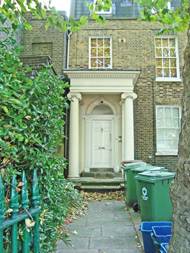
The entrance to 44 Grange Road.
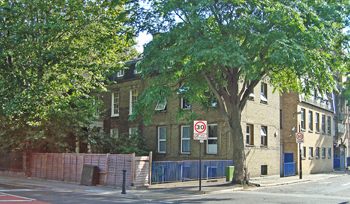
Lena Fox House is on the corner of Grange Road and Crimscott Road. The corner building, formerly No. 43 Grange Road, was rebuilt in 1966 following the line of the pre-existing house so that it would qualify for a grant from the War Damage Commission.
Update: December 2010
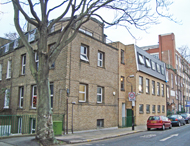
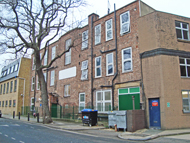
Lena Fox House, as seen from Grange Road looking down Crimscott Road (left). Lena Fox House at 41 Crimscott Road, seen from the south (right). It is now St Mungo's Grange Road Project.
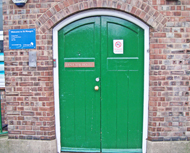
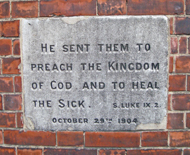
The main entrance on Crimscott Road (left). The masonry plaque for the Hospital was laid in October 1904 and still remains on the front of the building (right).
(Author unstated) 1914 Outside the gates. British Journal of Nursing, 11th July, 42.
(Author unstated) 1936 The Bermondsey Medical Mission Hospital. Resignation of members of staff. British Medical Journal 1 (3914), S13
(Author unstated) 1959 Obituary. Selina F. Fox, M.B.E., M.D. British Medical Journal 1 (5114), 119.
(Author unstated) (undated) Selina Fitzherbert Fox 1871-1958. Publisher unknown. (Booklet filed in the Rare Materials Room of the Wellcome Library).
www.missioncare.org.uk
www.southwark.gov.uk
www.thedesignspace.co.uk
Return to home page